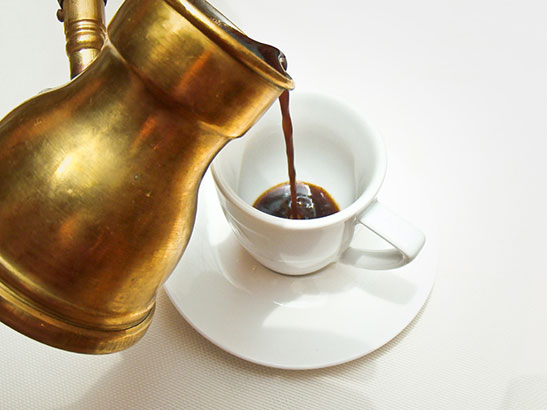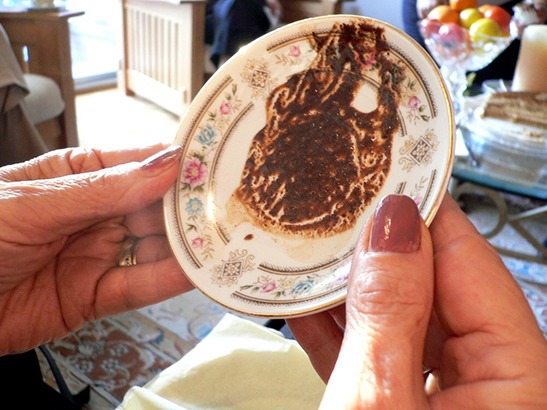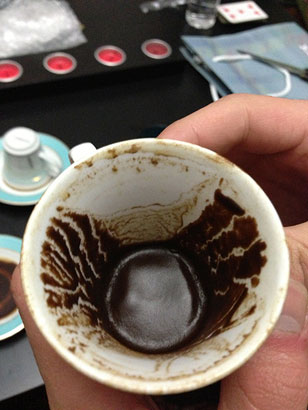Can the first coffee of the day really ‘tell’ what will happen to you for the rest of that day and well beyond into your future?

Coffee reading has been around for centuries. But in recent times there has been a revival with Lebanon at the forefront of this resurgence. So, Lebanon Traveler sent it’s reporter off to investigate. And after many cups of coffee and, hence sleepless nights, here is what he discovered.
But first, a brief history: The early origins of tasseography (coffee readings in this case) point to tea and China, that is until merchants began trading coffee across the Middle East, where Arab fortune tellers jumped the ‘tea ship’, so to speak, and began coffee readings in earnest.
This was way back in the 16th and 17th centuries and when elders of the community would secretly give readings to those desperately seeking a peek into their future.
To keep the skill alive, coffee reading was passed down to family members throughout the generations.
The Here and Now
Fast forwarding to the 21st century, it seems as if nearly every coffee shop in Beirut and beyond has a resident ‘coffee reader’: Kahwet Leila in Gemmayzeh, Cappuccino in Achrafieh ( +961 1 217 460 ), Public in Antelies, just to name a few. There are countless others; all you need to do is ask around.
Today, coffee reading in Lebanon is all about fun, or at least it should be, shouldn’t it? However, the abundance of ‘professional’ coffee readers, some gaining almost celebratory status, with charges to match and even having a secretary to maintain a strict booking system and a waiting list that span weeks, says otherwise.
How long have you been giving coffee readings and who taught you to ‘read’?
I have been doing it for 10 years. My cousin who studied astrology taught me by explaining to me what the signs in the coffee cup mean.
Do you believe in it?
No, it’s not a belief but I do think some people are more intuitive than others. I just do readings for friends and family at home in Rabieh.
How difficult is it to ‘read’ coffee?
It’s not difficult because it’s based on intuition and on the impression the reader gets from the person having their cup read.
How much do you charge?
Oh no, I don’t charge. It’s just for fun. I think the readers that sit in cafes and charge take advantage of people’s despair. Always have a reading with a neighbor or friend just for fun. Never base your decisions in life on a coffee reading.
Can anyone learn to ‘read’ or is it a gift?
I think some people are predisposed because they have a sense of receptiveness towards other people.
Do the cups used for the coffee reading make a difference?
I believe so. They have to be heavy, white inside, preferable the shaffé type, and the person has to have taken at least a sip.
Is there a certain time of the day when it is better to have a reading?
I don’t think the actual time of day matters but apparently readings on a Friday are more accurate. But I have no idea why.

A Hidden Army of Coffee Readers
Away from its public face, there is a traditional unseen army of coffee readers, hidden within many residential buildings nationwide. Mothers, sisters, aunts and daughters (and male equivalents, although less so), double up as soothsayers for friends, neighbors and family.
Lebanon Traveler located Maria (who didn’t want to give her family name), aged 44 and asked her to reveal the lowdown on coffee reading.
So, tell us about an unusual reading.
I once saw a snake in my neighbor’s coffee cup and the next day the neighbor found a snake in a lettuce she bought at the grocery store.
So, if you are Lebanese then the likelihood that you know a coffee reader on your street is quite probable. But what if you are a tourist just passing through?
Well, you can ask around in cafés and pay for coffee reading services. But if you want to have your coffee read by a housewife and for free then your best bet is to make some Lebanese friends.
GOOD TO KNOW

The 5 different cup zones and what they mean
- Part around the cup handle is connected to the love life.
- The left side of the cup handle represents the present.
- The bottom represents home and family.
- The opposite side of the cup handle represents financial situation.
- The right side of the cup handle represents the future.
Interpretations
- Alphabet letters in the reading refer to the initials of a person, place, etc.
- Numbers refer to time, date and age or anything else connected with that particular number that shows in the reading.
- Numerous dots in one spot refer to message, kissing or travel.
- Straight lines are considered as clear paths and plans with specific goals. Wavy lines mean instability in your life.
- If the entire cup is filled completely with very small symbols and lines it means your thoughts are unclear.
What’s in a Word?
- Tasseography, also known as tasseomancy or tassology, is a divination or fortune-telling method that interprets patterns in tea-leaves, coffee grounds or wine dregs.
- The terms derive from the French word tasse (cup), which in turn derives from the cognate Arabic word tassa, and the Greeks suffixes –graph (writing), -logy (study of), and – mancy (divination).
So You Want to Know Your Future? Here’s Where to Go.
- Beirut Corniche
Usually at night time; seek and you may find.
- Manara Palace Café (+961 1 364 949)
No set times.
- Café Rawda ( +961 3 679 237)
No set times.
- La Maison du Café (+961 1 332 300)
Wednesday & Friday.
- Cappuccino Grand Café (+961 70 771 616)
Monday.
- Public (+961 4 444 485 / 6)
Tuesday & Thursday.
- La Tasse (+961 3 679 237)
Every day except Wednesday & Sunday. By appointment only.
*Times may change. Call to check beforehand.
Article published on January 28, 2021.
Article edited on October 5,2021.
Loading
